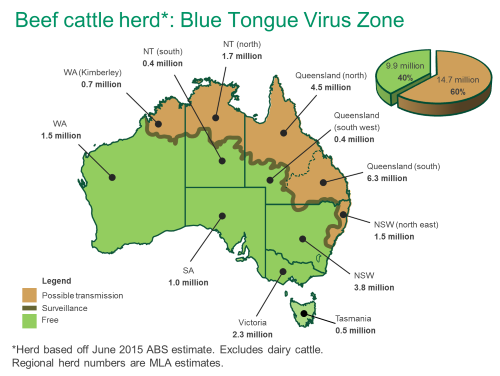60% of herd estimated within Blue Tongue Zone
Recent MLA analysis has investigated the distribution of cattle either side of the blue tongue* line. With respect to Australian feeder and slaughter cattle exports destined for China, different regulations exist on stock drawn from either side of the blue tongue line.
While not ruling out live cattle exports from within the Australian blue tongue zone, China's import regulations do favour cattle sourced from outside the blue tongue zone (predominantly southern Australia). To date, less than 500 head have been exported into China (from outside the blue tongue zone) since the signing of the new protocol last year.
So how many cattle are actually located within the blue tongue zone?
Using June 2015 herd estimates and the 29 August 2016 (latest available) blue tongue line, MLA estimate that approximately 60% of the herd is situated within the blue tongue zone. Of these cattle, the vast majority are located in Queensland, with the remainder situated in the Kimberley, the Top End, and coastal NSW. However, as the blue tongue line continues to shift and the northern herd switches into rebuild phase, the ratio of cattle either side of the line may change over time. Nevertheless, the majority of cattle will likely continue to exist within the blue tongue zone.

Furthermore, using average farm level turnoff data from the ABARES annual Australian Agricultural and Grazing Industries Survey, MLA estimate approximately 54% (or 4.9 million head) of national farm level turnoff** occurs within the blue tongue zone, with the remaining 46% (or 4.2 million head) coming from outside the zone (head turnoff based on June 2015 herd estimate). Higher fertility means southern Australia has higher branding and turnoff rates.
*Bluetongue is an insect-borne, viral disease that can affect sheep, goats, deer and cattle. A number of bluetongue serotypes are present in Australia, but the severe clinical disease seen in some other countries has not occurred in Australia. People are not affected by the virus. More information on the virus can be accessed here and the latest blue tongue map can be found here.
**Beef farm turnoff is defined as cattle leaving properties and could include transfers to restockers, feedlots, slaughter or live export. Hence, it does not necessarily represent cattle leaving the supply chain.
Click here to download a detailed copy of the blue tongue herd distribution and turnoff.



